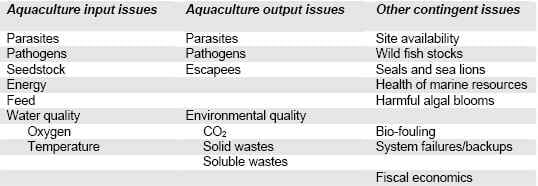The pressure is mounting, not only from environmental groups but also from government through tighter legislation.
Now salmon farmers have to ensure that there is no environmental impact caused through their activities and the measures they take to ensure that the aquatic environment is unaffected have to be made under strict scrutiny.
Recently, as an exercise to establish and assess potential new technology to ensure fish farm activity does not impact the environment, the Canadian government produced a report into closed-containment systems. Closed containment is one method that is now being used to restrict the interaction between farmed salmon and wild salmon.
The major environmental impact that aquaculture systems could have involve parasites and pathogens and the potential for farmed salmon to escape as well as water quality and problems with waste.

Data:Canadian Science Advisory Secretariat
Environmental pressures in particular are starting to turn the industry to consider closed containment systems and away from traditional net cage systems.
And the government of British Columbia has said that it is prepare to look at the feasibility of developing and cost-sharing a pilot project that is of a commercial scale in the waters off the coast.
The Canadian Science Advisory Secretariat report emerged following a workshop in Canada at the beginning of the year looking at a number of papers on the closed containment systems.
The report by the Canadian Science Advisory Secretariat, Assessing Potential Technologies for Closed Containment Saltwater Salmon Technology, said that a previous review had looked at 40 closed containment systems from around the world, but found there was none producing adult Atlantic salmon.
The secretariat's report said that where it had been attempted to keep adult salmon in closed containment systems, it had failed for numerous reasons, including mechanical breakdown, poor fish performance, management failure, a fall in market prices and poor financing.
This investigation had found that land-based salt-water flow-through systems (also called pump-ashore single-pass systems) have not worked for Atlantic salmon for a number of reasons including, high costs of operation, overly optimistic business models, engineering problems related to the challenge of pumping salt water to high heads (normally>8m), fouling of pipes and unforeseen system failures.
Five Different Systems Reviewed
The report reviewed five different types of closed containment system:
- conventional net pen;
- floating, closed-confinement systems with rigid walls;
- floating, closed-confinement systems with flexible walls;
- land-based flow-through system; and
- a land-based reuse system.
The engineering challenges associated with various designs of floating closed-containment systems were modelled.
"Those constructed of rigid material and anchored to the bottom represent a particular challenge in terms of the tidal currents and wave heights that are typical of exposed areas, which may mean that site selection for those types of structures may be limited by these two oceanographic factors," says the report.
"Possible engineering solutions may exist in the field of ship construction and hull forms. Land-based, solid-wall, recirculation and reuse technologies known as Recirculating Aquaculture Systems (RAS) exist and are used for the culture of high-value fish species that can be reared in fresh, brackish and/or salt water.
"This technology also shows promise for the rearing of salmon in fresh or brackish water due to the great potential for reducing energy costs associated with the pumping of sea water.
"In addition, the greatly reduced water requirements with RAS may permit the added expense of disinfecting of influent and/or effluent water in order to reduce pathogen transmission. However, a critical evaluation of the potential for rearing Atlantic salmon in fresh/brackish water is required."
The report said that parameters have been scientifically set for the water quality needed to raise Atlantic salmon, but it said that it was questionable whether the systems could maintain the water quality to raise salmon of 5kg or more.
Assessing Welfare Aspects
The report added that there also needs to be further work to assess the animal welfare aspects of rearing salmon at higher densities than are currently practiced.
"Changes to the husbandry environment involving closed-containment technologies, including increases in fish densities and hydraulic retention times, could increase the risk of pathogen exposure and horizontal transmission, relative to current systems," says the report.
"Disease risk assessments and quantitative monitoring of pathogen movement into, within and released from closed systems are required in order to identify critical control points.
"This information would then be used to more accurately deploy additional procedures and technologies aimed at reducing pathogen movements and disease risk."
The report concludes that any system that is established has to first make sure it fits in with the current market trends and meets the cost requirements of the business plan.
The system also needs to meet certain engineering and structural criteria and it needs to fit into certain biological operating parameters to ensure biosecurity.
It is imperative for success that the systems are managed correctly.
The Canadian Science Advisory Secretariat has called for further research into existing RAS technology, looking at areas such as water quality and the secretariat says that sites need to be investigated where these closed systems can be placed.
It says that further research is needed into other technologies, looking at their efficiency and at critical control points.
It concludes that in any closed containment system, areas such as the pH of the water, CO2 levels and the stocking densities among many points need to be carefully examined and criteria laid down for them.
Welfare aspects also need to have their controls set down and waste management measures also need to be specified.
Further Reading
| - | You can view the full report, Assessing Potential Technologies for Closed Containment Saltwater Salmon Technology, by clicking here. |
July 2008

